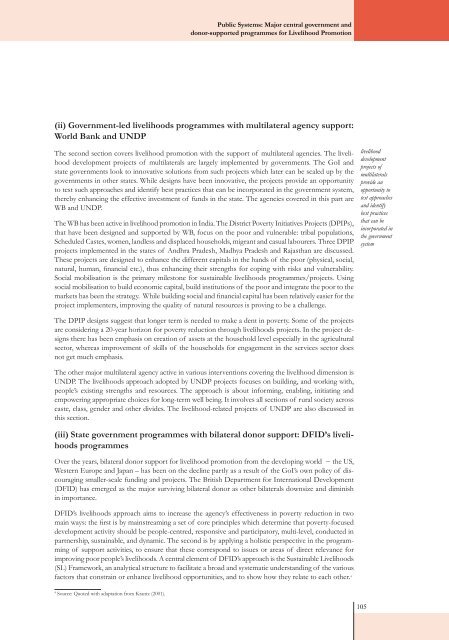SOIL Report 2008 - ACCESS Development Services
SOIL Report 2008 - ACCESS Development Services
SOIL Report 2008 - ACCESS Development Services
Create successful ePaper yourself
Turn your PDF publications into a flip-book with our unique Google optimized e-Paper software.
Public Systems: Major central government anddonor-supported programmes for Livelihood Promotion(ii) Government-led livelihoods programmes with multilateral agency support:World Bank and UNDPThe second section covers livelihood promotion with the support of multilateral agencies. The livelihooddevelopment projects of multilaterals are largely implemented by governments. The GoI andstate governments look to innovative solutions from such projects which later can be scaled up by thegovernments in other states. While designs have been innovative, the projects provide an opportunityto test such approaches and identify best practices that can be incorporated in the government system,thereby enhancing the effective investment of funds in the state. The agencies covered in this part areWB and UNDP.The WB has been active in livelihood promotion in India. The District Poverty Initiatives Projects (DPIPs),that have been designed and supported by WB, focus on the poor and vulnerable: tribal populations,Scheduled Castes, women, landless and displaced households, migrant and casual labourers. Three DPIPprojects implemented in the states of Andhra Pradesh, Madhya Pradesh and Rajasthan are discussed.These projects are designed to enhance the different capitals in the hands of the poor (physical, social,natural, human, financial etc.), thus enhancing their strengths for coping with risks and vulnerability.Social mobilisation is the primary milestone for sustainable livelihoods programmes/projects. Usingsocial mobilisation to build economic capital, build institutions of the poor and integrate the poor to themarkets has been the strategy. While building social and financial capital has been relatively easier for theproject implementers, improving the quality of natural resources is proving to be a challenge.livelihooddevelopmentprojects ofmultilateralsprovide anopportunity totest approachesand identifybest practicesthat can beincorporated inthe governmentsystemThe DPIP designs suggest that longer term is needed to make a dent in poverty. Some of the projectsare considering a 20-year horizon for poverty reduction through livelihoods projects. In the project designsthere has been emphasis on creation of assets at the household level especially in the agriculturalsector, whereas improvement of skills of the households for engagement in the services sector doesnot get much emphasis.The other major multilateral agency active in various interventions covering the livelihood dimension isUNDP. The livelihoods approach adopted by UNDP projects focuses on building, and working with,people’s existing strengths and resources. The approach is about informing, enabling, initiating andempowering appropriate choices for long-term well being. It involves all sections of rural society acrosscaste, class, gender and other divides. The livelihood-related projects of UNDP are also discussed inthis section.(iii) State government programmes with bilateral donor support: DFID’s livelihoodsprogrammesOver the years, bilateral donor support for livelihood promotion from the developing world − the US,Western Europe and Japan – has been on the decline partly as a result of the GoI’s own policy of discouragingsmaller-scale funding and projects. The British Department for International <strong>Development</strong>(DFID) has emerged as the major surviving bilateral donor as other bilaterals downsize and diminishin importance.DFID’s livelihoods approach aims to increase the agency’s effectiveness in poverty reduction in twomain ways: the first is by mainstreaming a set of core principles which determine that poverty-focuseddevelopment activity should be people-centred, responsive and participatory, multi-level, conducted inpartnership, sustainable, and dynamic. The second is by applying a holistic perspective in the programmingof support activities, to ensure that these correspond to issues or areas of direct relevance forimproving poor people’s livelihoods. A central element of DFID’s approach is the Sustainable Livelihoods(SL) Framework, an analytical structure to facilitate a broad and systematic understanding of the variousfactors that constrain or enhance livelihood opportunities, and to show how they relate to each other. 44Source: Quoted with adaptation from Krantz (2001).105














